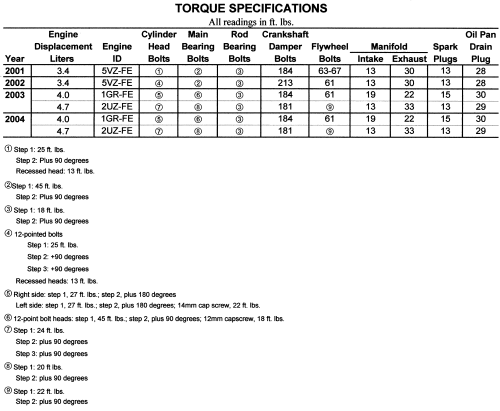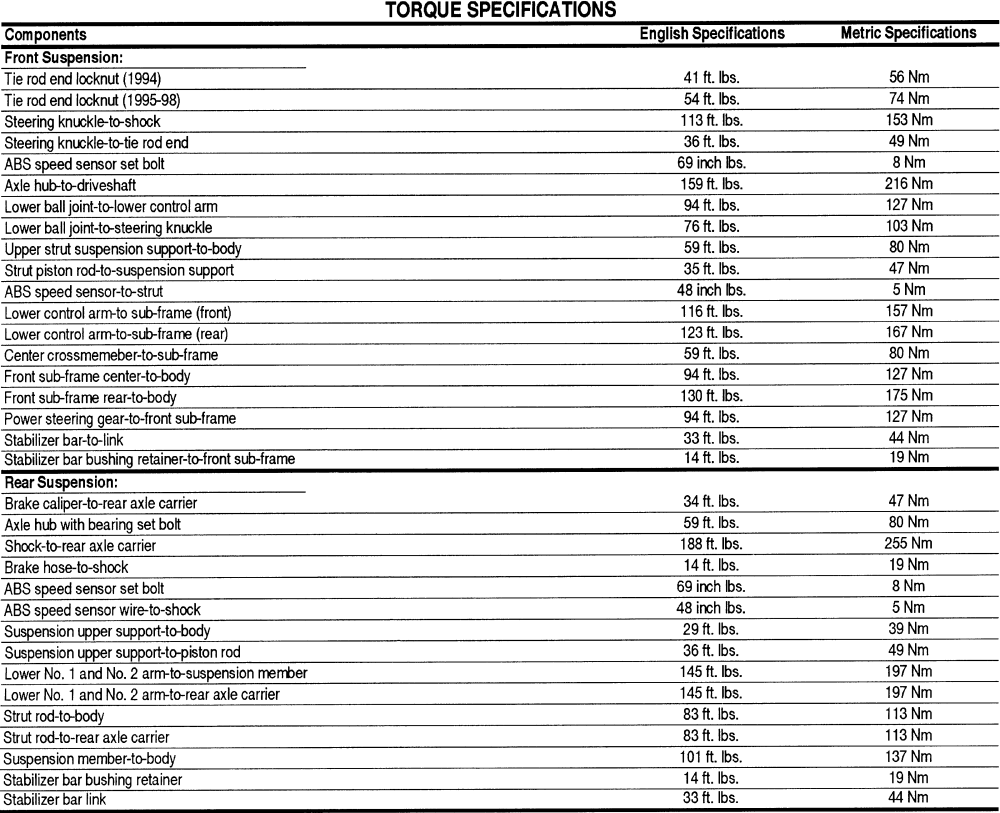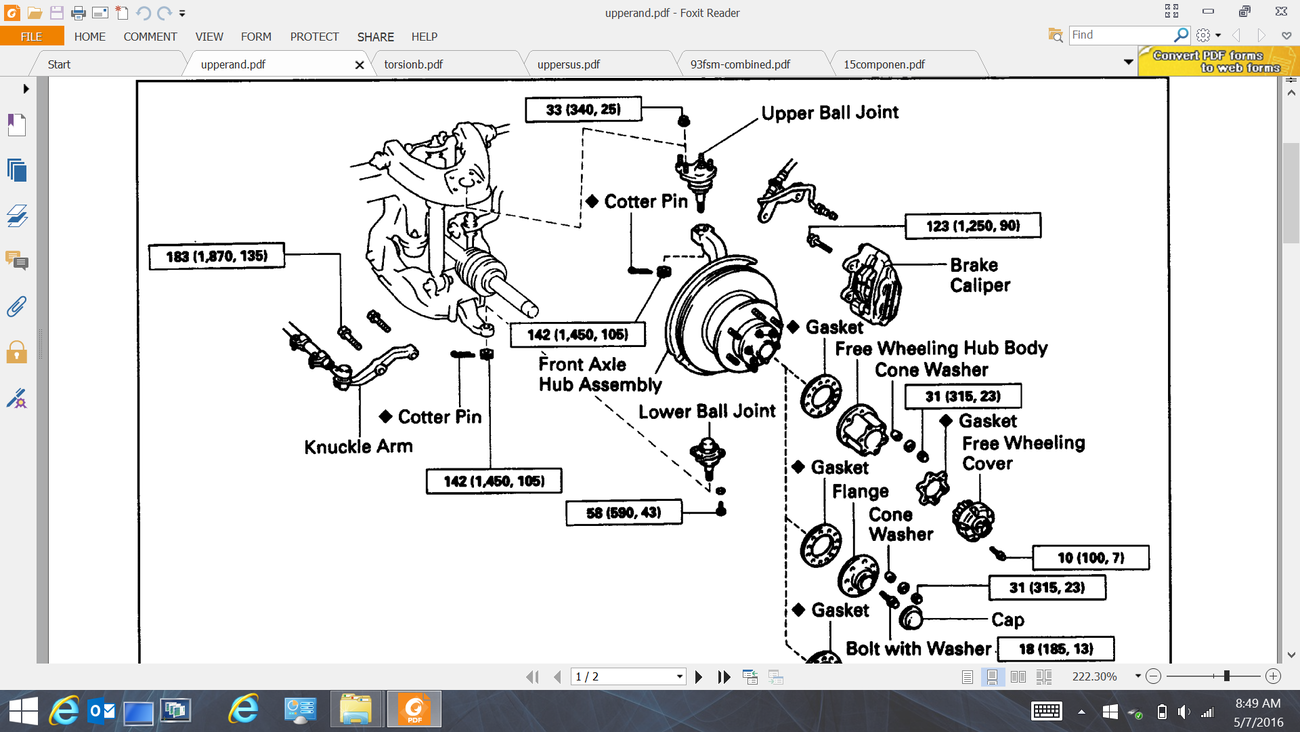Unlocking The Power Of Precision: A Comprehensive Guide To Toyota 4Runner Torque Specifications
Unlocking the Power of Precision: A Comprehensive Guide to Toyota 4Runner Torque Specifications
Related Articles: Unlocking the Power of Precision: A Comprehensive Guide to Toyota 4Runner Torque Specifications
Introduction
With great pleasure, we will explore the intriguing topic related to Unlocking the Power of Precision: A Comprehensive Guide to Toyota 4Runner Torque Specifications. Let’s weave interesting information and offer fresh perspectives to the readers.
Table of Content
Unlocking the Power of Precision: A Comprehensive Guide to Toyota 4Runner Torque Specifications

The Toyota 4Runner, a renowned SUV known for its rugged durability and off-road prowess, relies on a complex interplay of components to deliver its signature performance. Among these vital elements are the torque specifications, which play a crucial role in determining the vehicle’s power output, drivability, and overall efficiency. Understanding these specifications is essential for both owners and mechanics, enabling them to optimize the 4Runner’s performance, maintain its longevity, and ensure a safe and enjoyable driving experience.
Understanding Torque: The Force Behind Motion
Torque, in the context of automotive engineering, represents the rotational force applied to a shaft or axle. It is measured in Newton-meters (Nm) or pound-feet (lb-ft) and determines the vehicle’s ability to accelerate, climb hills, and tow heavy loads. Higher torque values generally translate to greater pulling power, allowing the engine to move the vehicle with greater ease and responsiveness.
Decoding the Torque Specifications: A Deep Dive into the 4Runner’s Powertrain
The 4Runner’s torque specifications are intricately linked to its engine and transmission configurations. Understanding these specifications requires delving into the specific model year and engine options available.
1. The 1996-2002 Toyota 4Runner: A Legacy of Power
These early 4Runner models were equipped with two primary engine options:
-
3.4L V6 Engine (5VZ-FE): This engine, known for its reliability and durability, produced a respectable 183 horsepower and 217 lb-ft of torque. These specifications offered a balance of power and fuel efficiency, making it suitable for both everyday driving and light off-road adventures.
-
4.0L V6 Engine (1GR-FE): Introduced in 1999, this more powerful engine delivered 236 horsepower and 266 lb-ft of torque. This significant increase in torque provided enhanced acceleration and towing capabilities, making it a popular choice for those seeking greater power and versatility.
2. The 2003-2009 Toyota 4Runner: A Refined Powerhouse
The 4Runner underwent a significant redesign for the 2003 model year, with the 4.0L V6 engine becoming the sole powertrain option. This engine, with its revised specifications, delivered 245 horsepower and 282 lb-ft of torque, further enhancing the 4Runner’s performance and off-road capabilities.
3. The 2010-2013 Toyota 4Runner: Building on a Solid Foundation
The 4Runner remained largely unchanged for this generation, continuing to utilize the 4.0L V6 engine with its proven 270 horsepower and 278 lb-ft of torque. This consistent power output ensured continued performance and off-road prowess while maintaining reliability and fuel efficiency.
4. The 2014-2023 Toyota 4Runner: Modernization Meets Legacy
The 2014 model year marked the introduction of a new 4.0L V6 engine, designed to enhance fuel efficiency while maintaining power. This engine generated 270 horsepower and 278 lb-ft of torque, effectively retaining the previous generation’s performance while incorporating modern technologies for improved fuel economy.
5. The 2024 Toyota 4Runner: A New Chapter in Power
While details are still under wraps, the 2024 4Runner is expected to introduce a new hybrid powertrain option, likely featuring a 2.4L turbocharged four-cylinder engine paired with an electric motor. This setup is expected to significantly enhance fuel efficiency while potentially delivering a substantial increase in torque.
Beyond Torque: The Importance of Other Powertrain Factors
While torque specifications play a pivotal role in determining the 4Runner’s performance, it is crucial to consider other factors that contribute to its overall powertrain efficiency and drivability. These include:
-
Horsepower: This metric represents the engine’s power output at a specific engine speed. While torque focuses on pulling power, horsepower is a measure of the engine’s ability to move the vehicle at higher speeds.
-
Transmission: The transmission plays a crucial role in translating engine power to the wheels. Automatic transmissions offer convenience and smooth shifting, while manual transmissions provide greater driver control and often improve fuel efficiency.
-
Drive System: The 4Runner offers various drive systems, including rear-wheel drive (RWD) and four-wheel drive (4WD). 4WD systems enhance traction and off-road capabilities, while RWD systems offer better fuel economy in everyday driving.
-
Gear Ratios: The gear ratios within the transmission and differentials determine how engine power is translated to wheel speed. Higher gear ratios provide greater torque multiplication, enhancing acceleration and climbing ability.
The Practical Importance of Torque Specifications: A Guide to Informed Decision-Making
Understanding the torque specifications of the Toyota 4Runner is essential for several reasons:
-
Performance Optimization: Knowing the torque output of the engine allows owners to choose appropriate modifications, such as performance exhaust systems or engine tuning, to enhance the vehicle’s power and acceleration.
-
Towing Capacity: The torque specifications play a crucial role in determining the maximum towing capacity of the 4Runner. Exceeding the recommended towing capacity can strain the engine and transmission, leading to premature wear and potential damage.
-
Off-Road Performance: High torque values are essential for off-road driving, enabling the 4Runner to climb steep hills, navigate challenging terrain, and overcome obstacles with greater ease.
-
Fuel Efficiency: While torque primarily influences acceleration and towing capabilities, it also plays a role in fuel efficiency. A properly tuned engine with sufficient torque can maintain optimal performance while minimizing fuel consumption.
FAQs: Addressing Common Questions about Toyota 4Runner Torque Specifications
Q: How does torque differ from horsepower?
A: Torque is the rotational force applied to a shaft or axle, while horsepower represents the engine’s power output at a specific engine speed. Torque is essentially the "pulling power," while horsepower is the "speed power."
Q: What is the best engine option for a Toyota 4Runner?
A: The best engine option depends on individual needs and preferences. The 4.0L V6 engine offers a balance of power and fuel efficiency, while the upcoming hybrid powertrain is expected to provide enhanced efficiency and potentially increased torque.
Q: How can I increase the torque of my Toyota 4Runner?
A: There are several ways to increase torque, including:
-
Performance Exhaust System: A free-flowing exhaust system can reduce backpressure, allowing the engine to breathe more freely and increase torque.
-
Engine Tuning: Reprogramming the engine control unit (ECU) can optimize engine parameters, including fuel delivery and ignition timing, to enhance torque output.
-
Supercharger or Turbocharger: These forced induction systems can significantly increase torque by compressing air entering the engine, increasing combustion efficiency.
Q: What are the torque specifications for the 2024 Toyota 4Runner?
A: The 2024 4Runner’s torque specifications are yet to be officially released. However, the new hybrid powertrain is expected to deliver a substantial increase in torque compared to previous models.
Tips: Maximizing Performance and Longevity
-
Regular Maintenance: Following the recommended maintenance schedule is essential for maintaining optimal engine performance and longevity.
-
Appropriate Fuel: Using high-quality fuel can improve engine performance and reduce wear and tear.
-
Driving Habits: Avoid aggressive acceleration and excessive engine revving, as this can lead to increased wear and tear.
-
Proper Towing: Always tow within the vehicle’s recommended towing capacity to avoid overloading the engine and transmission.
Conclusion: A Legacy of Power and Precision
The Toyota 4Runner’s torque specifications are a testament to its enduring legacy of power and performance. By understanding these specifications, owners and mechanics can optimize the vehicle’s capabilities, ensuring a safe, enjoyable, and reliable driving experience. As the 4Runner evolves with new technologies and powertrain options, its torque specifications will continue to play a crucial role in shaping its future, ensuring that it remains a dominant force in the SUV segment.


![]()


Closure
Thus, we hope this article has provided valuable insights into Unlocking the Power of Precision: A Comprehensive Guide to Toyota 4Runner Torque Specifications. We appreciate your attention to our article. See you in our next article!
You may also like
Recent Posts
- The 2025 Toyota 4Runner: A Legacy Reimagined
- The Enduring Appeal Of The Toyota 4Runner Manual Transmission 4×4
- The Toyota 4Runner TRD Off-Road: A Legacy Of Adventure, Reimagined For 2025
- The Anticipation Builds: Unveiling The Next Generation Toyota 4Runner
- The 2025 Toyota 4Runner TRD: A Legacy Of Adventure Reimagined
- The Future Of Color: Exploring The Significance Of Color Trends
- The Toyota 4Runner: A Legacy Of Capability, Now With Expanded Seating
- The Toyota 4Runner Timing Belt: A Vital Component For Engine Longevity
Leave a Reply